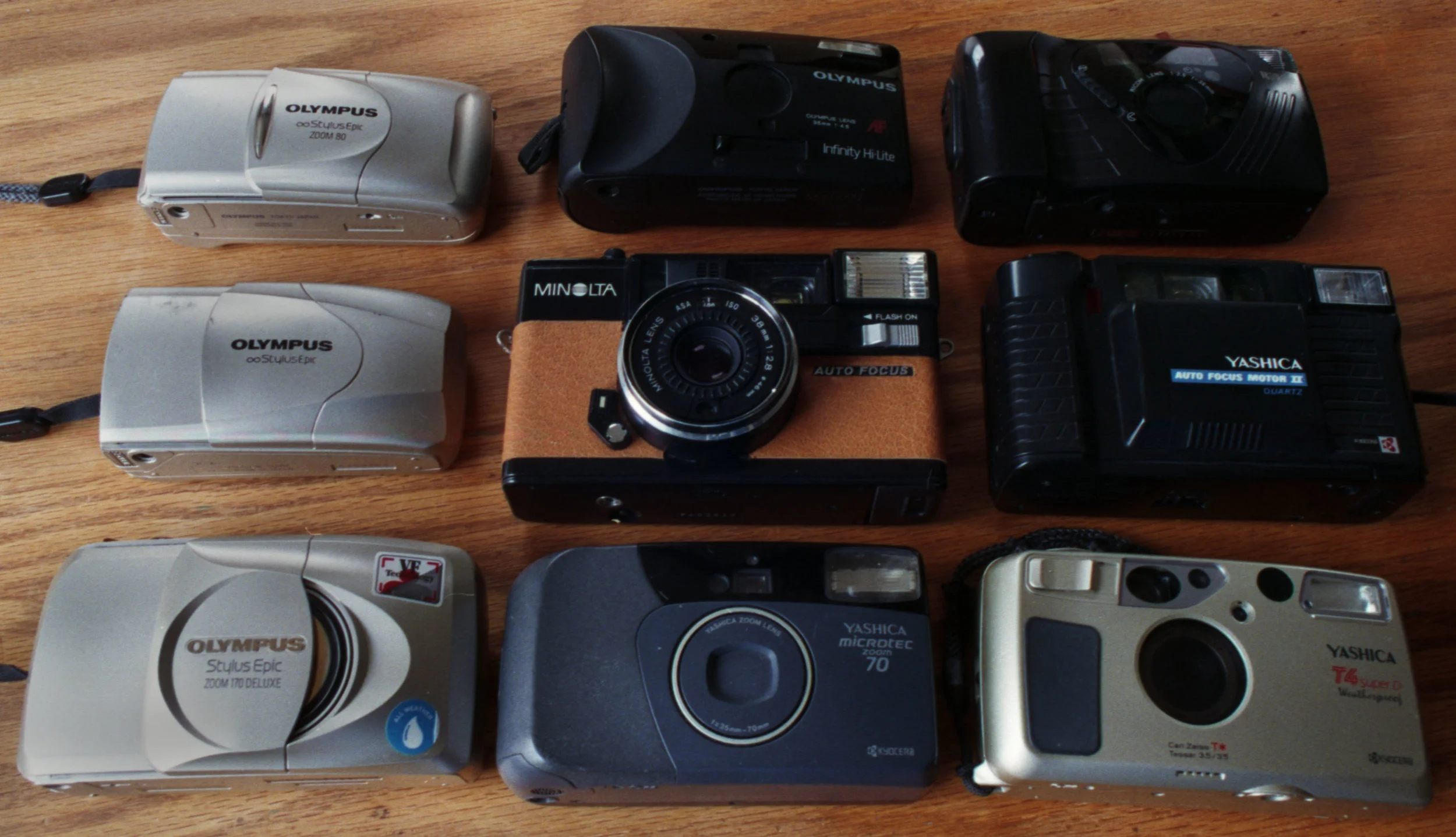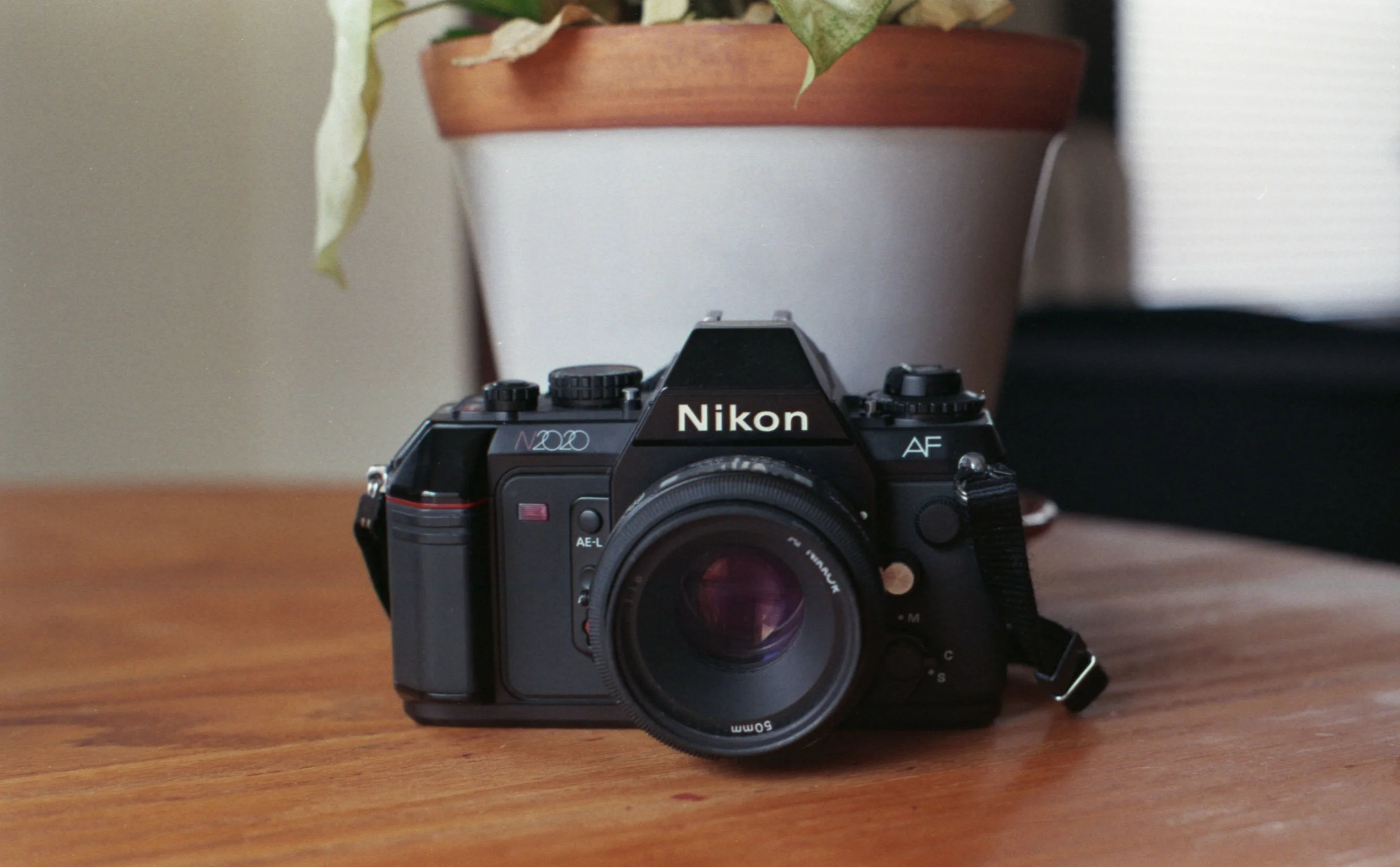March 31st 2019
Early Auto Focus Cameras
The Minolta Maxxum 5000, 7000, and 9000
I swear that Leitz was ahead of the game in every sort of camera innovation in the 20th century. In true Leica fashion, they first started patenting auto focus technology in 1960 and continued to develop their system over the next decade and a half. They kept it from the public until showing off their first auto focus camera in the 1976 Photokina and later their auto focus SLR in 1978. This caused a stir in the market and everyone was developing their own unique auto focus system. With add on attachments and even a sonar system, it was the wild west for design and innovation. This was the case until Minolta released the all in one fully integrated auto focus SLR, the Maxxum 7000. This was the end of most unique auto focus systems and created the standard and style of all SLR cameras we use today.
The Early attempts
Before the invention of auto focus, we had plenty of different focusing techniques from scale focus to the rangefinder and SLR. But in the 1960s there was a movement of automation in the camera manufacturing scene, and most of everything was automated except the focusing. Creating auto focus was no simple task, considering how much simpler measuring light for auto exposure was. They eventually got around to it in the mid 70s with a whole mess of different systems. Leitz kicked it off with the massive Lecia CK2 prototype with the auto focus attachment on the bottom of the camera. Pentax had their own unique auto focus integrated into the lenses, creating quite a chunky end to the lens. Probably the most unique at the time was the sonar focusing on the Polaroid SX-70 Sonar, quite the attachment but pretty snappy.
The first really truly successful auto focus camera was the Konica C35 AF in 1977. It was the first fully automated point and shoot camera and paved the way for much of the later auto focus point and shoot cameras to flood the market up until the 2000s. However you still had to wind the shutter manually, and the focusing was not as precise as later cameras. The focusing system was more or less adapted by taking three distinct zones (infinity, 3 meters, and 1.1 meters) and finding which one had the best focus. Not a terribly advanced system, but it was simple enough to keep in a compact camera marketed to the average consumer. There was a flimsy attempt by Nikon to get an auto focus SLR on the market, being the ill fated F3AF. Aside from being quite a rare item, it was not a fully integrated auto focus SLR camera. It was more tacked onto the Nikon F3 and I’m not sure it was even sold in stores considering how uncommon it is. The award for the first fully integrated auto focus SLR camera (to come to market) goes to none other than the Minolta Maxxum 7000.
The Essentials of imaging
The First auto focus SLR, the Minolta Maxxum 7000
Minolta was always on the cusp of what was new and trending in the photography world. It definitely shows how easily they stepped into the auto focus era. Minolta started out with the original Maxxum SLR line (5000, 7000, and 9000) and moved on into the thousands of iterations of the original three, along with multiple auto focus point and shoot cameras. Minolta was putting out quite a number of auto focus SLR cameras before being acquired by Sony in 2006. But it all started with the release of the Minolta Maxxum 7000 in 1985.
Being the first consumer auto focus SLR camera it’s very competent for being the first of its kind. Controls are situated in comfortable and logical places and there are quite a bit of options to choose from. An odd choice was the buttons replaced switches on this new camera, but do not fret, later on, they reserved nicer controls for the ‘professional’ cameras.
The amazing Minolta Maxxum 9000
The next year Minolta released a cheaper alternative to the 7000 in 1986, the Maxxum 5000. This camera was intended for a more beginner point and shoot style audience. There was a lot of features of the 7000 that were left out on the new budget model. There were really only three buttons that had any function, located under a cover on the top of the camera. You still had the same wide range of lenses to use along with the ability to go into a tad cumbersome full manual mode. It still is a competent camera for most photographers though, if you're into shooting in mostly auto. Minolta had the auto focus camera for the photography enthusiast and the beginner, but what about a more professional version? Around the same time they released the Maxxum 7000, Minolta decided to get into the professional market.
The main attraction in the Maxxum line, deemed as the professional Maxxum camera, was the amazing Minolta Maxxum 9000. This is one of my favorite cameras I’ve ever used, it just screams quality. Being mostly metal, this camera has some heft but a good weight behind it. There is a bigger focus on switches and dials too instead of buttons. Along with that you get hand winding and rewinding, but you do have the option of an external motor drive. It has any option you can think of as well, multiple shooting modes, different metering modes and even an aperture preview. This camera is a joy to work with and I cannot recommend it enough.
the cheaper alternative
The overly expensive Yashica T4 and Olympus Stylus Epic
As what happens with all technology, auto focus technology got smaller and cheaper. Soon everyone was in the auto focus market, creating hundreds of point and shoot cameras. As much of a Minolta fan as I am, yes there were other competitors who threw their hat into the SLR ring. Nikon had the N2000 series and Canon with the T80, but Yashica, Pentax, and many others didn’t really have a series that took off per se. Minolta seemed ahead of the game releasing SLR after SLR with no signs of slowing down. This was the case until a few things happened; Canon released the EOS series in the early 90s, APX was introduced, and the soon to be digital age was looming.
The auto focus SLR was a drop in the bucket compared to the huge market that sprung up in the mid 80s. The auto focus point and shoot flooded the market to great success for pretty much everyone. They were cheap to make and sold to the biggest photography audience, the average person. Your average adult at the time would use a camera maybe three times a year to take pictures at Christmas and a birthday, that was mostly it. Quality was not a factor for most people, it was price and convince. That’s why when you go to any thrift store you find dozens of cheap auto focus cameras lying around. But they really varied heavily in quality.
Don’t write them all off yet though, there are some really great ones to look out for. The Yashica T4 and the Olympus Stylus Epic are the first that come to mind for most people (and most google searches). But don’t think those are the only ones that matter, there are plenty more to choose from. One of my favorite things to do is go to a thrift store and grab a random point and shoot camera for a couple of dollars and test it out. You can find some real fun cameras that way, and possibly some hidden gems.
The Drawbacks
Multiple point and shoot cameras, all great performers
In my personal opinion, early auto focus cameras are great, and they only improved with time. But there are a handful of drawbacks that make people shy away. Early auto focus SLR cameras have a hard time in low light or anything that has the same color or shade to it. The main downside was the incorporation of using more plastic parts. This meant more opportunities for the camera to break or wear faster. Some auto focus cameras are over 30 years old and are starting to show their age. Motors slow down, LCD screens bleed and sometimes they just die for no reason. Along with that, a lot of the cameras had a short manufacturing run and have mostly proprietary lenses. Not many companies made 3rd party auto focus lenses, so you don’t really have much of a choice there. Sure you could use legacy lenses on most of the cameras at the time, but you wouldn’t get the auto focus feature of the camera. This makes a lot of the auto focus lenses lean more on the pricey side. Prime auto focus lenses are pretty difficult to find as well, naturally being in high demand. But if you have no need for a faster 50mm f/1.7 lens, the slower 35-70mm f/3.5 lens will do just fine for most people.
Don’t let these downsides sway you too much, just like older cameras there can be a lot of issues to deal with. I find more auto focus cameras that work then that are broken, so I would not worry too much. With the right care and maintenance, these cameras can last you a long time.
The Collectors Choice
One of my personal favorite cameras, the Nikon N2020
Some people despise auto focus on any camera, It doesn’t give them the kind of manual control they seek. But don’t let that sway you and take away from the enjoyment or tarnish the capability of a camera. Sometimes it’s nice to just go full auto and not think about anything. But if you're really against it, apart from point and shoot cameras, auto focus was an option on all SLR cameras. You can just as easily turn it off or attach an older manual focus lens if you want to go that route. I personally really enjoy the auto focus cameras I have in the collection. In fact, the camera I use for taking the pictures of the other cameras is the Nikon N2020. A wonderful camera with a lot of options and some fantastic super sharp Nikkor glass, once again highly recommended.
Auto focus may not be for everyone, but I don’t mind it once in a while. I enjoy the prospect of trying out something new and getting that certain feel and workflow you get from using a different camera. Auto focus has a different flow to it and may not be for everyone, but don’t let that discourage you. Get out there and give an auto focus camera a try, you may be surprised.






